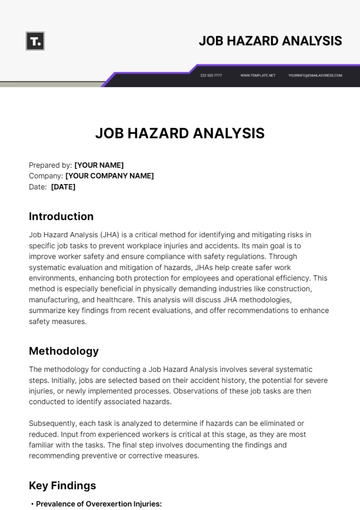Free Payroll Accounting System Analysis

Table of Contents
1. Executive Summary
2. System Overview
A. Current System Description
B. System Objectives and Performance Metrics
3. Process Analysis
A. Payroll Processing Workflow
B. Compliance and Regulations
4. User Experience and Satisfaction
A. Employee Interaction and Feedback
B. Administrative Ease and Challenges
5. System Efficiency and Accuracy
A. Error Rate Analysis
B. Time and Cost Efficiency
6. Technology and Integration
A. Current Technology Assessment
B. Integration with Other Systems
7. Recommendations and Future Outlook
A. Improvement Strategies
B. Future Trends and Technologies
1. Executive Summary
The Executive Summary of the Payroll Accounting System Analysis for [Your Company Name] meticulously compiles the essential aspects of the evaluation, offering a succinct yet in-depth overview of the system's current state. This analysis was primarily driven by objectives to assess the accuracy, compliance, and efficiency of the existing payroll processes. Key findings indicate that while the system maintains a high level of accuracy in payroll calculations and adheres to regulatory compliance, there are notable inefficiencies in process automation and data integration. The summary highlights these areas, emphasizing the need for system enhancements to streamline operations and improve overall efficiency.
Furthermore, this summary encapsulates the effectiveness of the current payroll technology infrastructure and its integration with other financial and HR systems. It reveals that despite the robustness of the existing setup, there is a significant opportunity for [Your Company Name] to leverage newer technologies and automation to reduce manual interventions and enhance data security. The potential for adopting advanced payroll solutions, integrating AI for predictive analytics, and improving user experience for both employees and administrators are identified as key areas for development. This executive summary serves as a strategic guide, pointing out both the strengths and areas for improvement, setting the stage for detailed exploration in the subsequent sections of the report.
2. System Overview
In this section, we provide a thorough overview of [Your Company Name]'s current payroll accounting system. This includes a comprehensive examination of the system's components, their functionality, and their integration into the broader financial framework of the company. This overview serves as the foundation for understanding the strengths and limitations of the existing system and sets the stage for subsequent analysis and recommendations.
A. Current System Description
In this subsection, we meticulously dissect the existing payroll accounting system at [Your Company Name], detailing its hardware and software components, user interfaces, and automation features. This examination provides a clear understanding of how the system operates and its integration within the company's financial framework.
Component | Description | Specification or Feature |
|---|---|---|
Software Platform | Core payroll processing application | Cloud-based, supports multi-state tax calculations |
Hardware | Servers and workstations for payroll processing | High-performance servers, secure workstations |
User Interface | Interface for payroll input and management | User-friendly, web-based interface with role-based access |
Automation | Automated features in the payroll process | Auto-calculation of taxes, automatic payslip generation |
System Integration | Integration with other financial systems | Seamless data flow with accounting and HR software |
Data Storage | Method and location of payroll data storage | Cloud storage with encrypted data protection |
This detailed breakdown of the payroll accounting system's components illustrates the complexity and sophistication of [Your Company Name]'s current setup, highlighting its capabilities and areas where technology aids efficiency and accuracy.
B. System Objectives and Performance Metrics
This part provides an evaluation of the goals set for the payroll system, such as accuracy, compliance, and timeliness. This includes a review of the key performance indicators (KPIs) currently used to measure the system's effectiveness and efficiency.
Objective | KPI | Current Performance | Target | Notes/Description |
|---|---|---|---|---|
Accuracy | Error Rate in Payroll Calculations | 0.5% | <0.2% | Measurement of inaccuracies in wage and tax calculations |
Compliance | Compliance Rate with Regulatory Requirements | 98% | 100% | Degree of adherence to tax laws and employment regulations |
Timeliness | On-time Payroll Processing Rate | 95% | 100% | Proportion of payrolls processed by the scheduled date |
Employee Satisfaction | Employee Feedback Score | 4.2/5 | 4.5/5 | Based on regular surveys assessing system usability and satisfaction |
Cost Efficiency | Payroll Processing Cost per Employee | $20 per employee | $15 per employee | Average cost incurred in processing each employee's payroll |
Through this detailed analysis of system objectives and performance metrics, we gain valuable insights into the operational strengths and improvement areas of [Your Company Name]'s payroll system. This systematic evaluation helps in aligning the system more closely with organizational goals and employee expectations.
3. Process Analysis
This section delves into the intricate processes and compliance aspects of the payroll system at [Your Company Name]. By thoroughly examining the workflow from time tracking to paycheck issuance and assessing adherence to various regulations, we gain critical insights into the system's efficiency and legal compliance.
A. Payroll Processing Workflow
This subsection provides an in-depth analysis of [Your Company Name]'s payroll processing procedure, dissecting each step of the process in detail. By examining each phase from time tracking to paycheck distribution, we gain a comprehensive understanding of the payroll workflow's efficiency and accuracy.
Step | Description | Tools/Software Used | Frequency |
|---|---|---|---|
Time Tracking | Employees log work hours using a digital timekeeping system. | Timekeeping Software | Daily |
Data Entry | Payroll staff input or verify time data and update any changes. | Payroll Software | Per Payroll Cycle |
Initial Calculation | Calculation of gross pay based on logged hours, including overtime. | Payroll Calculation Tool | Per Payroll Cycle |
Deductions Processing | Application of statutory and voluntary deductions from gross pay. | Deduction Management Tool | Per Payroll Cycle |
Approval Process | Supervisors and payroll managers review and approve payroll calculations. | Workflow Approval System | Per Payroll Cycle |
Paycheck Distribution | Distribution of final pay through direct deposit or physical checks. | Banking Software | Per Payroll Cycle |
Record Keeping | Maintaining payroll records for audit and compliance purposes. | Document Management System | Ongoing |
B. Compliance and Regulations
Here is an assessment of the payroll system's compliance with federal, state, and local tax laws, labor laws, and other regulatory requirements. The table below outlines the compliance of [Your Company Name]'s payroll system with various legal and regulatory requirements, highlighting its capacity to adapt to changes in these environments.
Compliance Area | Current Status | Tools/Systems Used | Adaptability Measures |
|---|---|---|---|
Federal Tax Laws | Fully Compliant | Tax Software Integration | Regular Legal Updates |
State Tax Laws | Fully Compliant in all operating states | State-specific Modules | State Law Tracking System |
Local Tax Laws | Compliant with local jurisdictions | Local Tax Database | Local Compliance Reviews |
Labor Laws | Compliant with FLSA and other labor standards | HR Management Software | Ongoing Labor Law Training |
Regulatory Audits | Successfully passed recent audits | Compliance Reporting Tool | Audit Preparation Protocols |
Legal Changes Adaptability | System updated for recent legal changes | Legal Update Subscriptions | Quick Response Team |
Through these comprehensive tables, [Your Company Name] demonstrates a meticulous and organized approach to payroll processing, ensuring not only efficiency and accuracy but also strict adherence to legal and regulatory requirements. This systematic workflow and robust compliance framework position the company well for operational excellence and future adaptability.
4. User Experience and Satisfaction
This crucial section of the analysis delves into the user experience and overall satisfaction with [Your Company Name]'s payroll system, both from the perspectives of the employees who interact with it and the administrators who manage it. This evaluation is essential for identifying areas for improvement and ensuring the system meets the needs of all users effectively.
A. Employee Interaction and Feedback
In this section, we analyze the responses gathered from employees about their experience with the payroll system. This feedback is crucial for understanding how the system meets the needs of its primary users and where improvements can be made.
Aspect | Satisfaction Rating (Out of 5) | Comments | Improvement Needed |
|---|---|---|---|
Payslip Accessibility | 4.0 | Easy access to current payslips | Better access to historical data |
Interface Navigation | 3.2 | Some find the interface non-intuitive | Enhanced user interface design |
Understanding Deductions | 3.5 | Mixed responses on clarity of deductions | More detailed breakdowns and explanations |
Mobile Access | 2.8 | Difficulties in mobile interface use | Development of a more user-friendly mobile platform |
Communication | 3.0 | Need more clarity on payroll changes | Improved communication channels for updates |
B. Administrative Ease and Challenges
This part provides an evaluation of the administrative experience, including the ease of managing and updating payroll data, handling discrepancies, and generating payroll-related reports. It also identifies any operational challenges faced by the payroll team. The table below outlines the experiences of the administrative team in managing the payroll system, highlighting both the strengths and the areas where enhancements are required.
Aspect | Effectiveness Rating (Out of 5) | Comments | Areas for Improvement |
|---|---|---|---|
Data Management | 4.5 | Efficient in updating standard data | Integration with HR systems for automatic updates |
Handling Discrepancies | 3.0 | Challenges in resolving errors | Streamlined process for error correction |
Report Generation | 3.2 | Time-consuming for complex reports | Enhanced reporting tools and templates |
System Integration | 3.5 | Adequate but could be improved | Better interoperability with other systems |
Compliance Maintenance | 4.0 | Generally effective in compliance upkeep | Ongoing training on regulatory changes |
These comprehensive tables provide a detailed view of the experiences of both employees and administrators with the payroll system at [Your Company Name]. The insights gained will be instrumental in guiding future enhancements to improve user satisfaction and administrative efficiency.
5. System Efficiency and Accuracy
In this section, we concentrate on the crucial aspects of system efficiency and accuracy in [Your Company Name]'s payroll process. By examining the error rates and evaluating the time and cost efficiency, we gain vital insights into the system's performance, ensuring that the payroll process is both reliable and cost-effective. We use statistical analysis to identify key areas of concern and opportunities for improvement.
A. Error Rate Analysis
Error Type | Frequency of Occurrence | Impact on Processing Time | Notes |
|---|---|---|---|
Incorrect Pay Calculations | 1.5% of payrolls | Adds 30 minutes per error | Mainly due to data entry errors or system glitches |
Tax Withholding Discrepancies | 0.8% of payrolls | Adds 20 minutes per error | Often caused by delayed updates in tax codes |
Overtime Rate Misapplication | 0.7% of payrolls | Adds 25 minutes per error | Incorrect application of overtime policies |
Note: These errors cumulatively affect approximately 2% of the total payrolls processed.
A meticulous analysis of error rates within the payroll process reveals several key findings. The most common errors identified are in pay calculations, often due to incorrect data entry or misapplication of overtime rates. Tax withholdings also show discrepancies, primarily due to updates in tax codes not being promptly reflected in the system. These errors, while relatively infrequent (occurring in approximately 2% of payrolls), have a notable impact on overall system efficiency, leading to additional time spent in error correction and potential delays in payroll processing. Importantly, these errors can also affect employee trust and satisfaction, indicating a need for enhanced accuracy checks and more timely system updates.
B. Time and Cost Efficiency
Evaluation of the time taken for payroll processing and the associated costs, benchmarked against industry standards to gauge efficiency.
Efficiency Metric | [Your Company Name] Performance | Industry Standard | Improvement Opportunity |
|---|---|---|---|
Average Time per Payroll Process | 4 hours | 3.5 hours | Automation of data verification |
Cost per Payroll Process | $50 per payroll | $45 per payroll | Streamlining error correction processes |
Manual Intervention Rate | 40% of payrolls | 30% of payrolls | Implementing advanced data entry checks |
Note: The manual intervention rate highlights the proportion of payroll processes requiring additional manual input or correction.
The analysis of error rates and time/cost efficiency of the payroll system at [Your Company Name] highlights critical areas for improvement. The relatively high frequency of pay calculation errors and tax discrepancies suggests a need for enhanced accuracy in data entry and more timely system updates. Additionally, the comparison with industry standards indicates that there is room to improve efficiency, particularly by reducing manual interventions and streamlining error correction processes. Addressing these areas will not only enhance the accuracy and reliability of the payroll system but also lead to significant time and cost savings, contributing to the overall operational efficiency of [Your Company Name].
6. Technology and Integration
This section critically assesses the technological infrastructure of [Your Company Name]'s payroll system, examining its current capabilities and how effectively it integrates with other business systems. By evaluating these aspects, we gain insights into the technological robustness and interoperability of our payroll system.
A. Current Technology Assessment
The current payroll technology at [Your Company Name] encompasses a range of tools and platforms, each playing a pivotal role in our payroll process. Our assessment reveals that while the core payroll software is proficient in handling basic payroll tasks, its scalability in response to our growing organizational needs poses a concern. The software efficiently handles standard payroll computations but shows limitations in processing complex scenarios, such as variable compensation structures. Security features, including data encryption and access controls, are robust, ensuring the protection of sensitive payroll data. However, the need for advanced analytics capabilities and AI-driven predictive tools is evident, which could significantly enhance payroll accuracy and foresight.
B. Integration with Other Systems
The integration of our payroll system with other key systems within [Your Company Name] is crucial for streamlined operations. Our analysis shows that the payroll system adequately integrates with the human resources management system (HRMS), allowing for seamless employee data transfer. However, integration with accounting software and time tracking tools could be improved. Currently, manual data reconciliation is often required between these systems, leading to inefficiencies and potential for errors. Enhancing these integrations would not only save time but also ensure data consistency across platforms, thereby improving overall operational efficiency and data integrity.
7. Recommendations and Future Outlook
In this final section, we synthesize the insights gained from the analysis to propose strategic recommendations for enhancing [Your Company Name]'s payroll system. We also explore future trends and technologies that could revolutionize our payroll processing, ensuring that the company stays ahead in a rapidly evolving digital landscape.
A. Improvement Strategies
The analysis of [Your Company Name]'s payroll system has led to the identification of key areas where strategic improvements can be made:
Process Optimization:
Automate routine tasks such as data entry and error checking to minimize manual errors and reduce processing time.
Implement streamlined workflows for more efficient payroll processing.
Technology Upgrades:
Invest in payroll software with enhanced scalability to accommodate business growth.
Incorporate advanced analytics features for better data analysis and decision-making.
Staff Training and Development:
Regular training sessions for payroll staff on new software updates and features.
Continuous education on compliance and regulatory changes to ensure up-to-date knowledge.
By implementing these strategies, [Your Company Name] aims to achieve a more efficient, accurate, and user-friendly payroll system, ultimately enhancing overall employee and administrative satisfaction.
B. Future Trends and Technologies
As we look to the future, [Your Company Name] is poised to leverage emerging trends and technologies to further enhance our payroll processing:
Cloud-Based Solutions:
Adoption of cloud technology for better scalability, flexibility, and security in payroll processing.
Access to real-time data and remote processing capabilities.
Artificial Intelligence and Machine Learning:
Integration of AI and ML for predictive analytics, offering insights into payroll trends and forecasting.
Automation of complex calculations and compliance checks.
Process Automation:
Employing automation tools for routine payroll tasks to improve efficiency and accuracy.
Streamlining data processing and report generation.
Embracing these trends and technologies will position [Your Company Name] at the cutting edge of payroll processing, ensuring adaptability and efficiency in a dynamic business environment.
Prepared by: [Your Name]
Company: [Your Company Name]
- 100% Customizable, free editor
- Access 1 Million+ Templates, photo’s & graphics
- Download or share as a template
- Click and replace photos, graphics, text, backgrounds
- Resize, crop, AI write & more
- Access advanced editor
Execute payroll tasks flawlessly with Template.net's Payroll Accounting System Analysis. This editable, customizable tool streamlines complex calculations while improving accuracy. Our AI-based editor tool permits seamless modifications. Unleash the potential of efficient accounting in your enterprise. Experience uncomplicated payroll management like never before. Take control today.





























